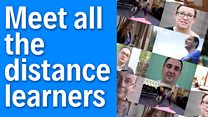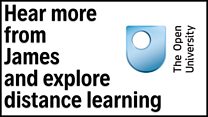Unit 8: Go The Distance: Social learning
Select a unit
- 1 Go The Distance: Choosing distance learning
- 2 Go The Distance: Academic reading
- 3 Go The Distance: Academic talk
- 4 Go The Distance: Academic writing
- 5 Go The Distance: Finding and using source material
- 6 Go The Distance: Going the distance
- 7 Go The Distance: Critical thinking
- 8 Go The Distance: Social learning
- 9 Go The Distance: Projects
- 10 Go The Distance: Succeeding in exams
Session 1
Student Life 8 – Social learning
Welcome back to Student Life – the series where we meet real distance learners and hear their study stories. Each student tells us about how they manage one specific aspect of distance learning. The feature of studying we're hearing about this time is very closely linked to advances in technology: social learning. Scroll down to meet James!
Activity 1
James puts a social spin on distance learning
You might think that being social online is just about sharing funny pictures and wasting time – but that's not what social learning is all about. MBA student James shares his experience of making the most of technology and social platforms in his distance learning life.
Scroll down to watch James' video and get the tips you need to get working and learning socially.
Learning with others around the world

James is a family man, civil servant – and an MBA distance learner. He uses online tools and social platforms to help him work with students from around the world. Watch the video to find out about the benefits of social learning for distance learners.
To do
While you watch, listen for what James says about working COLLABORATIVELY, dealing with TIME ZONES, and working in the CLOUD (write it down if you like). You can check your answers – in an activity – later on this page.
User tips
- Turn on subtitles by clicking on the 'S' button in the video player.
- Click on the 'expand' icon to view the video in full screen.
Watch the video

James
For me, before I started distance learning, I thought that the experience would be quite a solitary experience, with me just sitting in front of a computer and a few books. It's been far from that. It's kind of exceeded my expectations. I work with students virtually on a daily basis: both digitally, via social media, the online tutor group, video conferencing; and also through kind of social media channels, maybe WhatsApp, and different groups that we kind of set up to support each other.
With my - I suppose - work, and academic, and kind of hobbies and interests, being together as a family, you would perceive as being quite a challenge. But, I think I've managed to actually establish a pretty strong work-life balance: I definitely value family time. What we tend to do is make certain sections of our week, where we make time together and dedicate time together as a family.
So, my academic journey has not been as mapped out as most people. A couple of years before I started my GCSEs, I suffered from an illness, when I was younger. Actually, towards my GCSEs, I was home tutored and didn't come out with a full, massive array of qualifications. So, I kind of left school, but I didn't go into the university progression.
When, later on in life, I actually started working in the civil service, I got to a pretty good position, but I needed to try and improve my academic qualifications. So, I did my degree: BA Honours in leadership management. And I was fortunate enough, through the degree, to kind of pass with a first-class honours and actually get an International Student of the Year award for my academic achievements, which has fostered my academic journey into the masters', and it's something that has been a transformational, life-changing experience.
To work with students located across the world has been has been brilliant and I've developed a network of people and even friends. I'll give you an example where I've been working recently, collaboratively, with another student: we've been able to bring up a document, share it on the screen, and actually work on that document live.
Time zones is a challenge: trying to work out a time that's most convenient for everybody. We've got around those challenges by setting clear roles, clear expectations, clear timelines. I think if you take the time to make sure you've got the latest kind of software and programs to support it, you can transform your experience as a distance learner.
Personally, I've decided, over the years, to transfer all of my work into the cloud. The greater advantage that gives is I'm able to access it from any device at any location. I could be kind of travelling out and about and I could be updating stuff from my mobile. It gives you complete versatility on any device and I think that's been a big advantage for me.
And I think from the kind of network of contacts I've had from studying with distance learning, I have actually developed some lasting relationships; I can see myself kind of having that network many years later, even when I finish studying.
When I first started studying on a degree, I would work Monday to Friday. I would come home, I would do the family kind of life, and then I would just sit in front of my computer five nights a week. And then as I finished that and started my master's, I realised the importance of my health. So, for me, running gave me that opportunity to focus on my health, and then from that I've managed to build that up into longer-distance running and I'm looking to do the half-marathon a day before my master's exam, in the next coming months.
Go the distance.
Working digitally and socially
We asked you what James said about 1) working collaboratively, 2) dealing with time zones, and 3) working in the cloud. Did you pick up all three points?
Working digitally and socially
3 Questions
Answer the questions to check what you've understood from James's video
Help
Activity
Answer the questions to check what you've understood from James's video
Hint
James said that he could bring up a document on the screen and work on it live with another student – they could both write on it at the same time.Question 1 of 3
Help
Activity
Answer the questions to check what you've understood from James's video
Hint
James said that you can get around this challenge by "setting clear roles, clear expectations, clear timelines"Question 2 of 3
Help
Activity
Answer the questions to check what you've understood from James's video
Hint
James said transferring his work into the cloud means he is "able to access from any device at any location"Question 3 of 3
Excellent! Great job! Bad luck! You scored:
What we've learned
You've nearly reached the end of this unit. At the bottom of this page you can find links to more useful materials for distance learners – and would-be distance learners!
But before we finish, let's check what we've learned about using digital and social tools as a distance learner.
- Digital tools allow students around the world to communicate with each other and work together on documents live at the same time.
- Get around the challenge of working in different time zones by setting clear expectations about your work and individual roles is important.
- You might decide to transfer your work into the cloud – storing it online. This means you can access your documents from almost any location.
Find out more
There's lots more about James and his distance learning experience that you can see by visiting our partner The Open University. Click on the link below to find out more.
Where next?
Session Vocabulary
Find out more about distance learning – visit our partner,The OU


